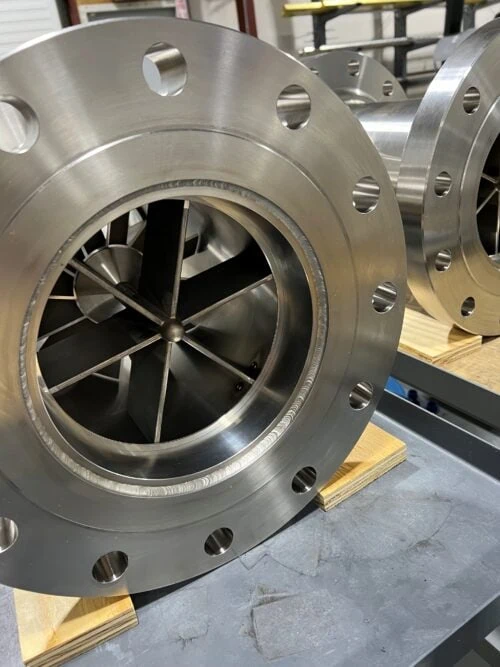Selecting the right turbine flow meter for your application involves much more than choosing a size that matches your pipe diameter. Turbine flow meters must be sized based on the system’s actual operating conditions—especially the flow rate, pressure, temperature, and fluid characteristics. Getting the sizing right ensures optimal performance, long-term reliability, and consistent accuracy.
Step 1 – Determine the Flow Rate of Your Media
Flow rate is the single most critical parameter when sizing a turbine flow meter. It defines how much fluid or gas is passing through the system and directly impacts which meter will perform best in your operating range.
Know Your Flow Rates
Before selecting a meter, identify the following:
-
Minimum Flow Rate: The lowest steady-state flow your system will experience. This ensures the meter can register and respond accurately at low velocities.
-
Maximum Flow Rate: The peak flow, even during short surges. The meter must tolerate this without over-ranging or becoming damaged.
-
Nominal Flow Rate: Your typical operating flow. This is the “sweet spot” where the meter should perform with the highest accuracy and repeatability.
These are typically measured in:
-
Liquids: Gallons per minute (GPM) or liters per minute (L/min)
-
Gases: Actual cubic feet per minute (ACFM)
Why Mid-Range Performance Matters
Turbine flow meters operate best when the nominal flow rate sits within the mid-range (roughly 30–70%) of the meter’s rated flow capacity. Operating at the low or high extremes can result in:
-
Decreased measurement accuracy
-
Increased mechanical wear
-
Poor signal repeatability
Sizing your meter based on flow—not pipe size—helps keep performance consistent over time.
Step 2 – Understand the Role of Pipe Size and Flow Velocity
Many users default to choosing a turbine meter that matches their pipeline diameter. But in reality, turbine meters measure velocity, not just volume. So the correct size is determined by how quickly the media moves through the pipe—not the pipe size alone.
Pipe Size vs. Meter Performance
Here’s what can happen if the meter size is not properly aligned with velocity:
-
Oversized Meter: At low flow velocities, the turbine rotor may not spin fast enough to register flow. This leads to under-reporting or missed measurements altogether.
-
Undersized Meter: Flow is forced through a smaller opening, increasing velocity and pressure drop. This can create backpressure and even damage the meter if flow exceeds the upper limit.
Recommended Sizing Approach
-
Start with flow rate to choose the ideal meter size
-
Then assess whether the meter’s line size matches your pipe
-
Use adapters if needed, but avoid configurations that introduce turbulence or backpressure
When properly sized, a turbine meter will deliver accurate readings without compromising your system’s pressure or flow dynamics.
Step 3 – Select the Right End Connection for Installation
The type of end connection determines how the flow meter will be integrated into your system. It must match your piping system in terms of mechanical compatibility, pressure rating, and environmental demands.
Common End Connection Types
-
NPT (National Pipe Thread)
-
Suitable for smaller line sizes and general-purpose installations
-
Threaded connections are easy to install and replace
-
-
ANSI Flanged
-
Ideal for high-pressure or heavy-duty applications
-
Provides robust sealing and mechanical strength
-
-
Tri-Clamp (Sanitary Clamp)
-
Used in clean applications like food, beverage, and pharmaceuticals
-
Enables easy disassembly for cleaning or inspection
-
Factors to Consider When Choosing Connections
-
Pressure rating: Ensure compatibility with system pressure
-
Fluid type: For corrosive media, select materials and seals that resist chemical degradation
-
Environment: In hazardous areas, explosion-proof or corrosion-resistant fittings may be required
Choosing the correct end connection will ensure safe, leak-free operation and support any regulatory or industry-specific compliance.
Step 4 – Match Application Specifications to the Right Meter Model
Once you’ve identified your flow range, pipe and fitting requirements, and environmental constraints, it’s time to select the right meter model. This ensures the flow meter you choose will deliver consistent performance throughout its lifecycle.
Key Selection Criteria
Look for a turbine meter that matches the following:
-
Flow range: Must fully cover your minimum to maximum flow rates
-
Pressure & temperature rating: The meter must withstand your system’s peak conditions
-
Viscosity & media type: Some turbine meters are better suited for low-viscosity fluids or compressible gases
-
Mounting orientation: Some meters are optimized for horizontal or vertical installation
-
Materials of construction: Choose based on chemical compatibility, durability, and cleanliness (e.g., 316 stainless steel, nickel alloys, etc.)
Example Turbine Flow Meters from Turbines Inc.
At Turbines Inc., we offer specialized turbine meters tailored for diverse applications:
-
HA Series – Engineered for high-accuracy liquid and gas measurement in industrial environments
-
LF Series – Designed for low-flow applications, offering precise measurement even at minimal rates
-
Cryogenic Series – Built to handle liquified gases like LN2, LOX, and LNG, with options for vacuum-jacketed insulation
Each series is customizable to your application’s specific pressure, temperature, and media requirements.
Take the Guesswork Out of Flow Meter Sizing
Properly sizing a turbine flow meter isn’t just a matter of matching diameters — it’s a science rooted in flow physics, system dynamics, and fluid behavior. By carefully evaluating your system’s flow range, line conditions, media characteristics, and installation needs, you can select a flow meter that provides consistent, accurate, and reliable measurements for years to come.
Turbines Inc. has been helping engineers, operators, and OEMs solve flow measurement challenges across industries like oil & gas, chemical processing, food production, and cryogenics.
Need Help Sizing a Flow Meter?
If you’re unsure about which turbine flow meter is right for your system, our flow specialists are here to help. We’ll guide you through the sizing process, provide compatibility recommendations, and ensure your meter delivers performance you can count on.
Contact our team at Sales@turbinesincorporated.com or Request a Quote online today.
